Tangerine was absolutely the rage at Sundance 2015. It was shot entirely on the iPhone by director-cinematographer Sean Baker and co-cinematographer Radium Cheung, who exploit the technology for all it is worth to create a totally original film, with a completely cinematic look. The reason that you should see Tangerine is for the inspired storytelling by a film director firing on all cylinders and the charismatic performances he elicits from a marvelous cast of newcomers in concert with seasoned Armenian professional actors. That the film was shot on iPhone may feel incredible – as in almost impossible to believe?! While the technology in no way detracts from or limits what they were able to achieve, use of the iPhone afforded Baker and his crew the opportunity to “shoot clandestinely,” in unique and authentic Los Angeles locales. Baker and writing partner Chris Bergoch spin straw to gold in this fresh, funny, by turns grim, contemporary fairy tale of life in La-La Land.
It is early in the day on Christmas eve, when transgender sex worker Sin-Dee Rella (Kitana Kiki Rodriguez) newly sprung from prison meets up with best friend, Alexandra (Mya Taylor), only to learn that during her absence, her pimp boyfriend Chester (James Ransome) has been unfaithful. The scorned woman sets off on a revenge rampage that is at once comical, endearing, and filled with irrepressible energy.
Tangerine is Sean Baker’s fifth feature film; it was produced by Mark and Jay Duplass. Baker has received Spirit Award nominations for earlier works that include Take Out, Prince Of Broadway, and a win, the Robert Altman Spirit Award, for Startlet. Baker is also one of the creators of the long running comedy television show, “Greg the Bunny” and its spin-off, “Warren the Ape.”
I was delighted to have an opportunity to speak with Sean Baker in a theatre in the Landmark Embarcadero film center in San Francisco about his remarkable, one of a kind odyssey, Tangerine.
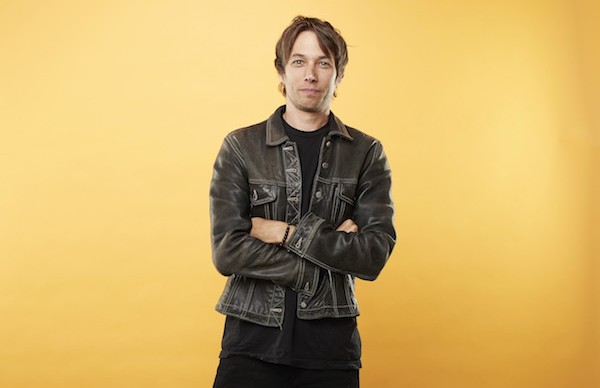
a Magnolia Pictures release. Photo courtesy of Magnolia Pictures.
Sophia: Of course, everybody at Sundance was talking about how your film, Tangerine, was shot on the iPhone. The thing is, Tangerine is a great film beyond the technological ingenuity. The script is really smart, the casting is phenomenal, and the film is so cinematic. Tell me about Sean Baker. Where did you grow up? When did you know that you were a film director?
Sean Baker: I grew up right outside of Manhattan, in New Jersey. I went to NYU to study film as an undergrad. I was actually very young when I discovered that I wanted to be a director — I’m talking like first grade. My mother brought me to the local library, and I know this dates me, but I think they were showing 16 mm loops of the old Universal monster films. I remember that burning mill scene at the end of James Whale’s Frankenstein, where you see his face looking through the interior of the mill as the mill is burning down, and I’m just like: I want to be a director!
So growing up, I did what everyone did: I did the Super 8 films, then the VHS films, and then I went to NYU and made some shorts. I went to NYU thinking I was going to make the next Die Hard, and then at NYU is where I discovered world cinema. It was really because I went to the library on Sixth Avenue and Eighth Street, and I found an Eric Rohmer film, Claire’s Knee (because it had a nice box cover), and I went: Well, I’ll rent this. So the next thing you know, I’m following French new wave, then I’m getting into British social realism and Italian neo-realism, and eventually, I made my way back all the way to Cassavetes. It was like, I think I’m liking this world.
Sophia: Did you know, from the start of making this film that you were going to tell a transgender story?
Sean: Because we were focusing on this corner of Santa Monica and Highland, which is sort of this unofficial red-light district in L.A. that is frequented by transgender sex-workers, we knew that the two leads would be transgender sex-workers. We just didn’t know what our story was going to be.
Sophia: This is a very hot topic, right at the moment – with Transparent (Jill Soloway’s award-winning series for Amazon) and Caitlyn Jenner —
Sean: When we set down the road two years ago, it was starting to brew, but it wasn’t as much. It is in the zeitgeist. We’re all thinking about it, and it is being brought to the forefront. The awareness is being increased day by day, which is a wonderful, wonderful thing. I had just come off a film called Starlet, which was about sex work, but in a totally different world. Starlet was about the San Fernando Valley and the porn industry. This was, I think, just a logical progression.
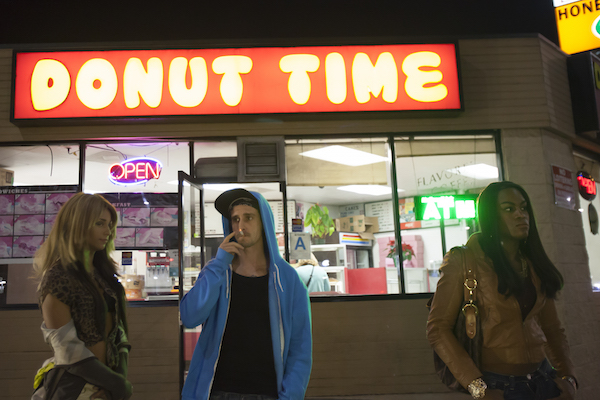
TANGERINE, a Magnolia Pictures release. Photo courtesy of Magnolia Pictures.
Sophia: Tangerine features a prominent location: Donut Time. Had you frequented that donut shop before you shot there?
Sean: Not frequented, but of course, I knew of it. I had been in there, and I had said, We’re not going to make this film unless we lock Donut Time because it’s such a landmark for that neighborhood. At one point, I remember almost having to consider shooting the interior somewhere else. “This is just going to be so inauthentic,” I thought. “It’s not going to work.” Thank, God, my great producers – Shih-Ching Tsou and Darren Dean – made it happen. I remember the day it happened. It was one of those few moments where it was like: We got it, thank, God! –But we only had Donut Time for two and a half days, and we couldn’t interfere with their business. We had permission to shoot inside, but if a customer came in, we had to stop.
Sophia: That big, climatic scene takes place inside Donut Time, and it has a lot of characters!
Sean: A lot of characters. That was crazy because I don’t know Armenian, so it had to be scripted out to the word so I knew where to focus my camera, because I was co-cinematographer on Tangerine. Even if I didn’t know exactly what she is saying, I would know that I had to be on that character at that time. It was all blocked out. It was actually the most rehearsed scene of the entire film. We would rehearse it in our little apartment, which was also our office. We realized that when we got to Donut Time, we were going to have to be incredibly efficient because if we walked away from those two days without getting what we needed, we wouldn’t have a movie. So it was probably one of the most stressful couple of days of my life, but we walked away with a great scene. …And we begged for an additional half-day, I think. So we shot for two and a half days total in Donut Time.
Sophia: You and your co-screenwriter, Chris Bergoch, conducted some research at the LGBTQ Center on McCadden?
Sean: We were actually doing research on the street around that area. There happen to be two centers that serve the community: one center focuses on youth at risk and the other is an LGBTQ center that just has basic services for the community and a beautiful courtyard. This center is located on the same block, but on the other side, so it’s sort of isolated. That’s where we discovered Mya Taylor. She was actually hanging out in the courtyard one spring morning with some friends, and there was something about her.
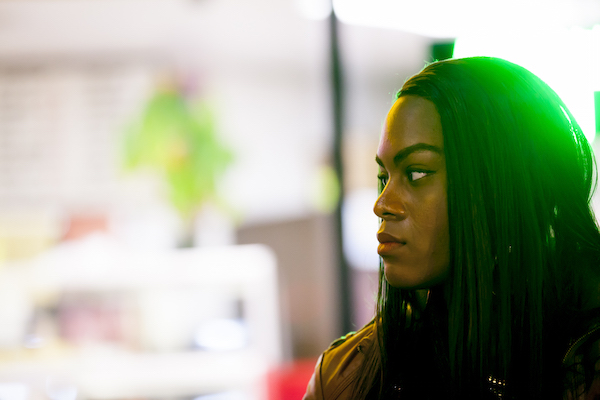
a Magnolia Pictures release. Photo courtesy of Magnolia Pictures.
Sophia: She is magnetic on screen. And so too, is Kitana Kiki Rodriguez. How did you know you had found what you were after, had found “IT,” when you found the two of them?
Sean: Mya had two things: she had not only that persona and that IT quality that drew me to her, but she also had that total enthusiasm. Both Mya and Kiki are both aspiring entertainers. The moment that I saw Mya from across the courtyard, her physicality was drawing me in. Then when I approached her, I saw that she was just a great personality, as well. She had this enthusiasm, and I said, “Let’s stay in touch.” We started meeting weekly at the local Jack In The Box and just talking about stories. Mya was telling me about the experiences of her friends who have worked the block. She was very open about the struggles and hardships they had encountered. We were still trying to break the story, and then one day, Mya brought Kiki to the table. Kiki sat down, and I was just looking at these two, and I just thought: Oh, my God, this is like a dynamic duo, a comedic duo. They have these two almost clashing personalities, but they’re friends. And they compliment each other. I remember looking at Chris, and I’m like: I think we have our two leads. We just had to figure out what the story was.

a Magnolia Pictures release. Photo courtesy of Magnolia Pictures.
Sophia: At the heart of the story is this great friendship – a pair of best friends, friends who function as surrogate family for one another in the world on Christmas eve … which is very poignant and moving. You named your lead character, Sin-Dee Rella. In what ways were you playing with the classical fairy tale to create a contemporary, grim Fairy Tale?
Sean: That’s where I have to say that I have this great partnership going on with Chris – because we come from two different worlds. My taste lies in art house cinema, world cinema, and indie stuff – sometimes not the easiest films for mainstream audiences. Chris is on the other side of the spectrum. He is a Disney freak. He knows everything that Lucas and Spielberg have ever done. He is as mainstream as you can get. So we meet somewhere in the middle. He is the one who pitched me for the story to take place on Christmas eve, the classic Die Hard [paradigm] – you know, these films all take place on Christmas eve in L.A. Not only that, but he was the one who brought Sin-Dee Rella to the table. All those little Disney aspects, that was Chris.
Sophia: What is your process writing together?
Sean: We break the story together, usually in a collaborative way. In this case, we worked heavily with Mya and Kiki. It was a few months in, and we still hadn’t figured it out. I had told them early on, “All I know is that all of our characters converge at Donut Time. I think our main plot should be about two people finding each other. But that’s all I know … It could be a love story, or it could be a vengeance story — I don’t know …” So we threw around all these ideas, and none were clicking. Over the course of that time, I was hearing all these anecdotes from Mya – stories about the way that girls work the block. So we kept those on reserve in the back. Then one day, Kiki said: “Well – if you want a story about two people coming together, there is this one story, based on this semi-true story about a sex-worker who found out that her boyfriend was cheating on her with a fish.” And we were like, “What’s a fish?” And that lead to us thinking, there’s so many layers to that story – it’s a journey story, it’s a road movie. That can be our A-plot, and then we can take all those anecdotes that we have been hearing over the last month and sprinkle those in for our B-plot.
Sophia: You have this big B-plot, with Razmik, the Armenian cabbie, who is leading a double life. How did that story come into the mix?
Sean: That story comes just from the desire to work with Karren Karagulian; he’s the guy in all of my films. He’s one of the two leads in Prince of Broadway, and he has a semi-smaller role in Starlet. He’s such a talented actor. It’s very similar to what these girls go through because there aren’t roles out there for people with accents, for Armenian actors. It’s unfair because Karren is extremely talented, and he just still hasn’t been signed by an agent. It’s ridiculous. Anyway, it was my desire to work with him, so I asked him, “Karren, I’m making this film about two transgender sex-workers on Christmas eve and the only interaction that they would possibly have with the Armenian community would probably be through a taxi, so any thoughts?” Karren suggested, “I’ll play the taxi driver, and I’ll be cheating on them.” I was like, “Got it.” So we all came together.
I was extremely lucky because the Armenian cast members are all superstars in Armenia. Alla Tumanian, who plays the mother-in-law, is the Sophia Loren of Armenia. She’s an incredible professional, a classic actor who has been around acting since the sixties. Arsen Grigoryan, who plays the other cab driver, he’s actually the Howie Mandel of Armenia; he appears on Armenian television in The Voice. So I was lucky to work with these superstars of Armenia in this tiny, little movie.
Sophia: I’ve got to ask you about the car wash scene because that is unforgettable. What was the inspiration for that particular scene?
Sean: That actually goes way back. I’ve always wanted to shoot a one-take car wash scene — whether it was going to be somebody murdered in a car wash or something like what happened in Tangerine, I just knew I had to do it. The car wash is very visual, and that was probably one of the first images that we had for the film. I live right behind the carwash, so I knew that we would be able to use that location. I also wanted to work with sound in that way. I knew that that would be our moment where our sound designer could really shine and do a beautiful surround sound — as if you’re actually inside the car in that moment with those two.
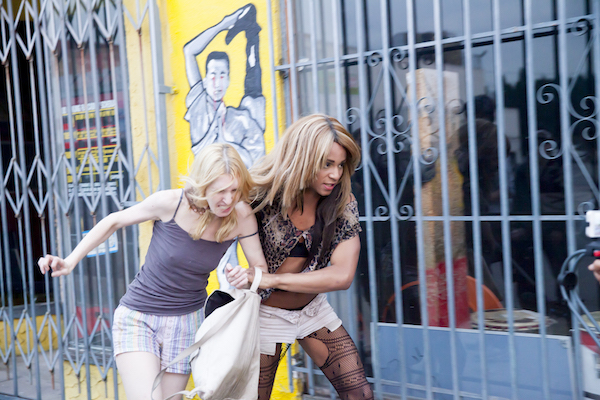
a Magnolia Pictures release. Photo courtesy of Magnolia Pictures.
Sophia: The soundtrack is really eclectic and playful and fun. What was your concept for the sound design?
Sean: I actually didn’t discover it until post-production. Early on, I was following a Viner, her name is Wolf Tyla — she’s nineteen years old, out of New York, an NYU student, I believe. She posts a lot of hip-hop and Trap music. She’s like a Vine celebrity, right. So one of her Vines just struck a chord with me — no pun intended. It was this Trap music that I hadn’t heard before. I’m not really into that sort of music. Basically, I heard this music and realized this is the vibe of the movie. So I reached out on SoundCloud to the artists who made it and got their permission to use it. Next thing you know, it dictated the style of the entire movie.
SoundCloud is an incredible tool for independent filmmakers because it allows the filmmaker to reach out directly to the artist to negotiate a price. Being an artist, I always wanted to give them something. I didn’t want to ask for their tracks for free. I didn’t have much to work with, so they were generous enough to give us their tracks for a couple of hundred dollars, at most. We were able to pull together a really thick soundtrack for around fifteen hundred dollars. It was amazing. It was amazing! As soon as we got to that point in the film where Sin-Dee is contemplating going to war — I used that Beethoven track, a public domain track that has very high production value that I found for free, as well — suddenly, I was like: Wait, we don’t have to just stick with Trap music. This can become this eclectic mix, in which we have jazz, we have shoegaze, we have belly dancing music — I mean, we have everything in there! I edited mostly in chronological order. As I would feel the vibe of the scene, I’d choose the music, reach out to the artist for permission, and then cut the scene on the beats to that music.
I had time on my hands because we shot in December 2013 going into January 2014, and Mark Duplass wanted to wait for Sundance — which was a year away. So I had a good eight months to edit this movie.
Sophia: There is this scene where Dinah confronts Alexandra when she learns that Alexandra pays for the privilege to sing in the nightclub. Of course, many actors in L.A. pay to act as members of a theatre company. In fact, creatives of all types pay for the privilege, for the necessity of expressing themselves.
Sean: All creatives have dealt with that at one point or another in their lives. I remember playing a pay-to-play film festival, back with my first film in 2000. I was like: I just paid them two hundred dollars to show my film to my friends?! So that scene was actually based on stuff that I think all artists have experienced and can identify with.

a Magnolia Pictures release. Photo courtesy of Magnolia Pictures.
Sophia: I would be remiss if I don’t bring up the fact that you shot this movie with the iPhone because a lot of our readers are filmmakers or aspiring filmmakers. So the issue is, how did you and Radium Cheung get the iPhone to do all the wonderful things you got it to do?
Sean: We just made our own kit. Basically, I found this Kickstarter campaign for a company called Moondog Labs; they had created a little anamorphic adapter which allowed the iPhone to shoot in wide-screen, capturing at true-scope. The adapter was tiny. Literally, it was like a matchbook. You wouldn’t even notice it from across the room. Then there was a Steadicam Smoothee, a stabilizer which is only about a foot long. So still the unit is quite small. And then, there’s an app called Filmic Pro; the company is actually located up here in the Bay area. The app locks your phone at 24 frames a second, and it has all these other bells and whistles that bring the picture up to a cinematic level. So all those things combined. And then, of course, treating it in post-production by adding grain and bringing up the saturation really just gave it that look. I had shot tests, and I showed these tests to Mark and Jay Duplass and the other investors, Marcus and Karrie Cox. Before we shot the film, we were able to bring the test footage to Technicolor and blow it up on a big screen, and we all thought: You know what, this looks really good. It looks very different. It doesn’t look amateur; it has its own aesthetic. It almost looks like one of those old, 16-mm films, transferred to video and then back again. It looked very unique, and we were very happy with it. We just thought, yeah, let’s go for it.
Sophia: The film looks gorgeous. As I was watching it, I found myself marveling at how you got that tool, the iPhone, to work in that way?! What are you going to attempt technologically speaking on your next project? Do you know yet?
Sean: Well, the next film, I’ve said, we have to shoot it on 35 mm – because we have to just flip it. We can’t do what people expect. We can’t shoot it on the Galaxy. We have to go celluloid just to mix it up. We have about three projects [in the works] right now, and we’re still seeing which one gets financing first. No matter how visible you are in the film community, you are still struggling to get financing. So we have three different projects, at three different budget levels. I’m passionate about all three, and all three are very different. It really comes down to whether financiers will step up.
Top Image: Kitana Kiki Rodriguez (Sin-Dee Rella) in TANGERINE, a Magnolia Pictures release. Photo courtesy of Magnolia Pictures.
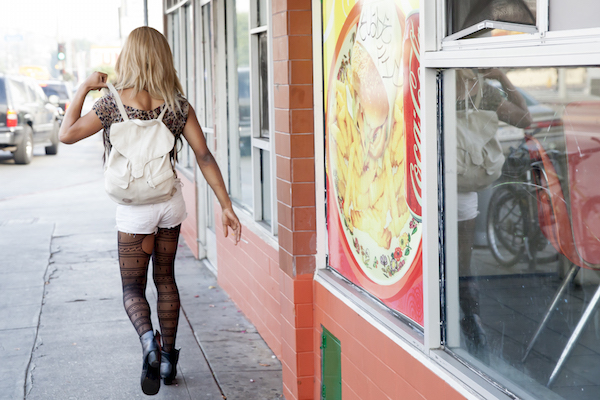
a Magnolia Pictures release. Photo courtesy of Magnolia Pictures.
